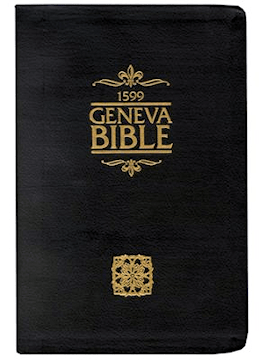Textus Receptus Bibles
Geneva Bible 1560/1599
| 12:1 | Afterward Miriam and Aaron spake against Moses, because of the woman of Ethiopia whome hee had maried (for hee had married a woman of Ethiopia) |
| 12:2 | And they saide, What? hath the Lord spoken but onely by Moses? hath he not spoken also by vs? and the Lord heard this. |
| 12:3 | (But Moses was a verie meeke man, aboue all the men that were vpon the earth) |
| 12:4 | And by and by the Lord sayd vnto Moses, and vnto Aaron, and vnto Miriam, come out yee three vnto the Tabernacle of the Congregation: and they three came forth. |
| 12:5 | Then the Lord came downe in the pillar of the cloude, and stoode in the doore of the Tabernacle, and called Aaron and Miriam, and they both came forth. |
| 12:6 | And hee saide, Heare nowe my wordes, If there be a Prophet of the Lord among you, I will be knowen to him by a vision, and will speake vnto him by dreame. |
| 12:7 | My seruant Moses is not so, who is faithfull in all mine house. |
| 12:8 | Vnto him will I speake mouth to mouth, and by vision, and not in darke wordes, but hee shall see the similitude of the Lord. Wherefore then were ye not afraid to speake against my seruant, euen against Moses? |
| 12:9 | Thus the Lord was very angrie with them, and departed. |
| 12:10 | Also the cloude departed from the Tabernacle: and beholde, Miriam was leprous like snowe: and Aaron looked vpon Miriam, and beholde, she was leprous. |
| 12:11 | Then Aaron saide vnto Moses, Alas, my Lord, I beseech thee, lay not the sinne vpon vs, which we haue foolishly committed and wherein we haue sinned. |
| 12:12 | Let her not, I pray thee, be as one dead, of whome the flesh is halfe consumed, when he commeth out of his mothers wombe. |
| 12:13 | Then Moses cryed vnto the Lord, saying, O God, I beseech thee, heale her nowe. |
| 12:14 | And the Lord said vnto Moses, If her father had spit in her face, shoulde she not haue bene ashamed seuen dayes? let her be shut out of the hoste seuen dayes, and after she shall bee receiued. |
| 12:15 | So Miriam was shut out of the hoste seuen dayes, and the people remooued not, till Miriam was brought in againe. |
| 12:16 | n/a |

Geneva Bible 1560/1599
The Geneva Bible is one of the most influential and historically significant translations of the Bible into English, preceding the King James translation by 51 years. It was the primary Bible of 16th century Protestantism and was the Bible used by William Shakespeare, Oliver Cromwell, John Knox, John Donne, and John Bunyan. The language of the Geneva Bible was more forceful and vigorous and because of this, most readers strongly preferred this version at the time.
The Geneva Bible was produced by a group of English scholars who, fleeing from the reign of Queen Mary, had found refuge in Switzerland. During the reign of Queen Mary, no Bibles were printed in England, the English Bible was no longer used in churches and English Bibles already in churches were removed and burned. Mary was determined to return Britain to Roman Catholicism.
The first English Protestant to die during Mary's turbulent reign was John Rogers in 1555, who had been the editor of the Matthews Bible. At this time, hundreds of Protestants left England and headed for Geneva, a city which under the leadership of Calvin, had become the intellectual and spiritual capital of European Protestants.
One of these exiles was William Whittingham, a fellow of Christ Church at Oxford University, who had been a diplomat, a courtier, was much traveled and skilled in many languages including Greek and Hebrew. He eventually succeeded John Knox as the minister of the English congregation in Geneva. Whittingham went on to publish the 1560 Geneva Bible.
This version is significant because, it came with a variety of scriptural study guides and aids, which included verse citations that allow the reader to cross-reference one verse with numerous relevant verses in the rest of the Bible, introductions to each book of the Bible that acted to summarize all of the material that each book would cover, maps, tables, woodcut illustrations, indices, as well as other included features, all of which would eventually lead to the reputation of the Geneva Bible as history's very first study Bible.